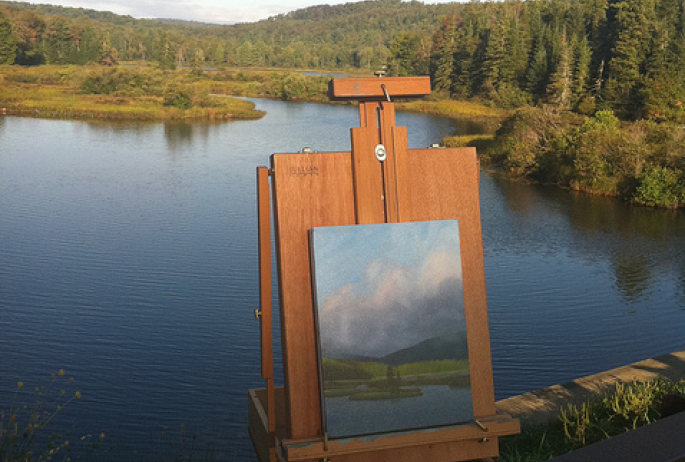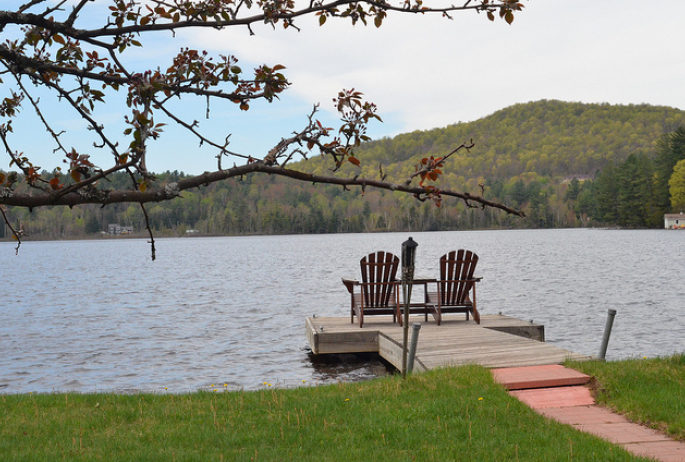What is Adirondack style?
It is a relaxed blending of the natural world with classic comfort elements. It was developed in the rugged wilderness, when a few innovative people arrived who were not intent on conquering and subduing the forces of nature. Instead, Adirondack style embraces and appreciates it. It is a way of seeking a partnership with nature.
Architecture
This difference exhibited itself most profoundly in the influential architecture of the Adirondack Great Camps.
The people who owned the Great Camps were the very rich of their day, and they were used to mansions. But even their resources would have been stretched to the limit by attempting to recreate their luxurious homes in the remote woods. Hauling heavy materials, assembling it with imported workers who knew how to create these mansions, and dealing with the challenges of the dense bedrock and extreme freezing temperatures of winter was too daunting to attempt with the transportation options of the time.
Instead, architects and builders decided to work with what they had on the site, using local workers who were experienced with these materials. Thus was born Adirondack architecture. Wooden logs and granite ledges, twig and bark touches, the mirroring of nature forms in man-made structures that are now commonly seen in the Adirondack Park, didn't only shape the look of the Park.
It would go on to have an far-reaching influence on the rest of the world.

Prior to the innovations of the Adirondack style, resort architecture of the time had an emphasis on whimsy and the unusual. The choices made in the Adirondacks were so influential that they reversed that trend. Now the challenge was to nestle human habitations into their environment. Perhaps the most extreme example was the 1939 house known as Fallingwater which was built over an actual waterfall by the architect Frank Lloyd Wright.
Master builder Benjamin A. Muncil was a local (born in Vermontville, New York) who had a background as a lumberman, guide, and camp caretaker by his late teens. He is credited with the use of "brainstorm siding" in the United States, which is a kind of cladding which keeps the bark on and the edge untrimmed. This creates a characteristic wavy-edged look instead of the even clapboards common in classic New England designs.
Such strategies enhanced the way a building blended into its setting. Buildings with uneven roofing angles, variably-sized windows, unpeeled logs, branch-based railings, and native, rough-cut stones all became integral parts of the Adirondack style.
See how all of these design philosophies fit together by touring one of our most iconic Adirondack Great Camps, White Pine Camp.
Art
The Hudson River School of painting acted as an early form of public relations for the Adirondacks. The lush, romantic, landscapes which were painted and then reproduced on prints and postcards put images of the wilderness into hands and onto walls all over America.
Today, arts are still an important part of the Adirondack experience. We have a yearly Plein Air Festival which gathers artists to paint our beautiful vistas in the open air, where people can watch them at work. We are a popular destination for those seeking our dramatic wilderness settings, for any creative endeavor.

Our wilderness inspires potters, photographers, and artisans of all kinds. Our combination of easy nature access and enjoyable civilization draws casual weekend hobbyists and dedicated professionals. Those without these abilities can browse and acquire the work of our many local artists, from giant landscapes suitable for hanging above the mantel to darling miniature pieces to thrill a collector.
The animals of the Adirondacks were the inspiration for the lovely Adirondack Carousel which is part of our downtown. Sculptors created detailed and delightful riding versions of such well-known Adirondack sights as squirrels, bobcats, bears, frogs, and more.

Explore Saranac Lake's art galleries and the Adirondack Carousel.
Decorating
When the outside of the room reflects the wilderness, we often want the inside to do the same thing. Our local artisans can help with lovely items chosen to evoke the great outdoors. From rustic furniture to mugs with an acorn motif, we can take the Adirondacks home, and eat breakfast with it.
Many classic design templates have been reworked with more modern materials. Now, the antler chandeliers have been cast from a mold, to take the pressure off animals who grow the originals. Where once the raw materials seemed as endless as the mountains themselves, we now rely more on recycled and renewable sources.

But most of all, Adirondack style emphasizes comfort. Sturdy, over-stuffed furniture invites sprawling. Informal dining styles evoke a relaxing cookout, while bedrooms open their windows to the sunrise and the fresh air. Nature is reflected in the prints on the walls and the chintz in the kitchen.
It can be silly or it can be sophisticated, but it is always cheerful and welcoming.
Find something wonderful in our Adirondack shops.
Lifestyle
When I arrived in the Adirondacks a decade-and-a-half ago, I was asked my favorite winter activity. My answer of "reading" was met with knowing smiles. Sure enough, I became almost as active outdoors in the winter as I was in the summer.
The winters are different up here, that was part of it. A sunny day without wind can be as warm as our layers allow. Enjoying snowshoeing and cross-country skiing keeps our body heat perking along. But it's also an attitude. Nature is always a close and beautiful part of our lives here.
We don't want to be away from it.

Some things have changed, of course. The skis are lighter and easier to care for, and we might be kayaking in lightweight plastic instead of a wooden canoe. Where once the layers were genuine wool, we now have fleece.
But some things have not changed at all. We shrug off weather as just another part of nature. We show up for events anyway. We watch the leaves turn each autumn and the sunlight off the water each evening with the same sense of wonder and joy. We pause to let each other make turns and are happy to share a favorite hiking or paddling spot. (Fishing, of course, is different.)
Here is a timeless place where much of what we revel in are the same things generations have enjoyed before us. The lakes, the mountains, and the woods don't change.

We love it. And we love to share.
Explore your own sense of Adirondack style by choosing a favorite lodging. Find local ingredients in our dining spots. Explore our outdoors and indoors with our local attractions.
Header photo: Knollwood boathouse, Shingle Bay, Lower Saranac Lake, 27 June 2009 (UTC) Taken by User:Mwanner, 18 October, 2007 from Wikimedia Commons.












